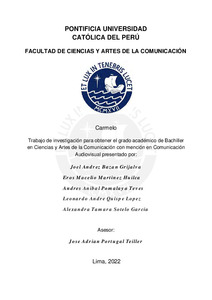| dc.contributor.advisor | Portugal Teillier, Jose Adrian | |
| dc.contributor.author | Bazan Grijalva, Joel Andrez | |
| dc.contributor.author | Martinez Huilca, Eros Macelio | |
| dc.contributor.author | Pomalaya Teves, Andres Anibal | |
| dc.contributor.author | Quispe Lopez, Leonardo Andre | |
| dc.contributor.author | Sotelo Garcia, Alexandra Tamara | |
| dc.date.accessioned | 2022-08-30T01:36:35Z | |
| dc.date.available | 2022-08-30T01:36:35Z | |
| dc.date.created | 2022 | |
| dc.date.issued | 2022-08-29 | |
| dc.identifier.uri | http://hdl.handle.net/20.500.12404/23194 | |
| dc.description.abstract | La presente investigación busca detallar los procesos que formaron parte de la realización del
cortometraje “Carmelo” inspirado en el cuento “El Caballero Carmelo” de Abraham
Valdelomar. Esta adaptación tiene como objetivo representar tres vínculos diferentes: la
indiferencia, el abuso de poder y el amor. Así, para la representación de estos vínculos se
buscó adaptar los personajes que conformaban el cuento original y ubicarlos dentro del
contexto de una familia en un entorno violento tanto por la dinámica familiar como por la
labor que llevaba a cabo el personaje principal: las peleas callejeras. Es en ese sentido se
describirán todas las etapas de realización, tales como la motivación y la razón de ser del
cortometraje junto al desarrollo narrativo de las escenas y perfil de personajes, así como el
aspecto técnico que engloba las distintas áreas como Producción, describiendo los procesos
de casting y locación; Dirección, mencionando cuál fue su participación desde la etapa de
pre-producción; Dirección de Fotografía, desde donde se muestra cómo fue la composición
estética del cortometraje; Dirección de Arte, donde se gestó junto al encargado de fotografía
cada uno de los matices estéticos que aportarían el desarrollo de arte a la narrativa del
cortometraje; Sonido, mencionando entre otras el plan de post de sonido con grabación de
foley realizado y Edición. Además, se desarrolla un plan que describe el proceso que
atravesará de manera tentativamente el cortometraje “Carmelo” dentro de la etapa de
distribución tanto desde el aspecto de la retribución económica como desde la sola
exhibición. | es_ES |
| dc.description.abstract | This research seeks to detail the processes of making “Carmelo”, a short film inspired by the
book story “El Caballero Carmelo” by Abraham Valdelomar. “Carmelo” aims to represent
three important points with different characteristics: indifference, abuse of power and love. In
order to show these points, we look to adapt the main characters from the original story (the
book story) and place them in a context of a family violent environment, because of the
family dynamics and the main character’s environment and job: street fights. It is in this
sense that all the stages of production will be described, such as the motivation and reason for
being of the short film together with the narrative development of the scenes and character
profiles, as well as the technical aspect that encompasses the different areas such as
Production, describing the casting and location processes; Direction, mentioning what their
participation was from the pre-production stage; Direction of Photography, from where the
aesthetic composition of the short film is shown; Art Direction, where each one of the
aesthetic nuances that would contribute the development of art to the narrative of the short
film was conceived together with the person in charge of photography; Sound, mentioning
among others the sound post production plan with foley recording made and Edition. In
addition, a plan is developed that describes the process that the short film "Carmelo" will
tentatively go through during the distribution stage, both from the aspect of economic
compensation and from the sole exhibition. | es_ES |
| dc.language.iso | spa | es_ES |
| dc.publisher | Pontificia Universidad Católica del Perú | es_ES |
| dc.rights | info:eu-repo/semantics/openAccess | es_ES |
| dc.rights.uri | http://creativecommons.org/licenses/by/2.5/pe/ | * |
| dc.subject | Cortometrajes--Producción y dirección | es_ES |
| dc.subject | Comunicación--Planificación | es_ES |
| dc.subject | Comunicación audiovisual | es_ES |
| dc.title | Carmelo | es_ES |
| dc.type | info:eu-repo/semantics/bachelorThesis | es_ES |
| thesis.degree.name | Bachiller en Ciencias y Artes de la Comunicación con mención en Comunicación Audiovisual | es_ES |
| thesis.degree.level | Bachillerato | es_ES |
| thesis.degree.grantor | Pontificia Universidad Católica del Perú. Facultad de Ciencias y Artes de la Comunicación | es_ES |
| thesis.degree.discipline | Ciencias y Artes de la Comunicación con mención en Comunicación Audiovisual | es_ES |
| renati.advisor.dni | 10811932 | |
| renati.advisor.orcid | https://orcid.org/0000-0002-8685-049X | es_ES |
| renati.author.dni | 71403080 | |
| renati.author.dni | 74124496 | |
| renati.author.dni | 72573183 | |
| renati.author.dni | 73994159 | |
| renati.author.dni | 73036434 | |
| renati.discipline | 211086 | es_ES |
| renati.level | https://purl.org/pe-repo/renati/level#bachiller | es_ES |
| renati.type | https://purl.org/pe-repo/renati/type#trabajoDeInvestigacion | es_ES |
| dc.publisher.country | PE | es_ES |
| dc.subject.ocde | https://purl.org/pe-repo/ocde/ford#5.08.00 | es_ES |






